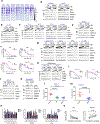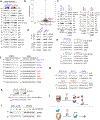Distinct CDK6 complexes determine tumor cell response to CDK4/6 inhibitors and degraders
- PMID: 34568836
- PMCID: PMC8462800
- DOI: 10.1038/s43018-021-00174-z
Distinct CDK6 complexes determine tumor cell response to CDK4/6 inhibitors and degraders
Abstract
CDK4/6 inhibitors (CDK4/6i) are effective in metastatic breast cancer, but they have been only modestly effective in most other tumor types. Here we show that tumors expressing low CDK6 rely on CDK4 function, and are exquisitely sensitive to CDK4/6i. In contrast, tumor cells expressing both CDK4 and CDK6 have increased reliance on CDK6 to ensure cell cycle progression. We discovered that CDK4/6i and CDK4/6 degraders potently bind and inhibit CDK6 selectively in tumors in which CDK6 is highly thermo-unstable and strongly associated with the HSP90/CDC37 complex. In contrast, CDK4/6i and CDK4/6 degraders are ineffective in antagonizing tumor cells expressing thermostable CDK6, due to their weaker binding to CDK6 in these cells. Thus, we uncover a general mechanism of intrinsic resistance to CDK4/6i and CDK4/6i-derived degraders and the need for novel inhibitors targeting the CDK4/6i-resistant, thermostable form of CDK6 for application as cancer therapeutics.
Figures














Comment in
-
PROactively TACkling CDK4/6 therapy resistance.Nat Cancer. 2021 Apr;2(4):372-373. doi: 10.1038/s43018-021-00193-w. Nat Cancer. 2021. PMID: 35121999 No abstract available.
References
-
- Sherr CJ, Beach D & Shapiro GI Targeting CDK4 and CDK6: From Discovery to Therapy. Cancer Discov 6, 353–367, doi: 10.1158/2159-8290.CD-15-0894 (2016). - DOI - PMC - PubMed
Publication types
MeSH terms
Substances
Grants and funding
LinkOut - more resources
Full Text Sources
Medical
Molecular Biology Databases

